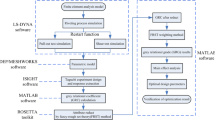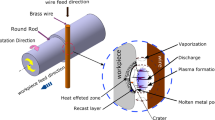Abstract
For a blade with complex shape, preform design plays an important part in the quality of an achieved part in the forging process. So many optimization methods were developed in many researches to obtain an optimal preform. However, in these researches, they lack accuracy and efficiency in defining preform shape, and there is no systematical strategy of implementing multi-criterion optimization processes. In order to overcome these defects, a function-driven shape definition method was proposed in this paper. This method can transform geometrical shape into numerical variables which define geometrical shape easily and can be used in mathematical functions in such methods as Taguchi method and response surface method. Besides, a novel Taguchi method coupling with gray relational analysis (GRA) and entropy measurement method (EMM) was developed, which provides a systematic way of optimizing preforms from the perspective of multi-criterion. In this method, GRA transforms multiple objectives into gray relational grade and EMM determines the weights of objectives. Finally, these two methods were applied in blade preform optimization to validate their effectiveness and efficiency. The results showed that the optimized blade was decreased by 16.6% in strain variance and by 20.2% in total load.











Similar content being viewed by others
References
Alimirzaloo V, Biglari FR, Sadeghi MH (2011) Numerical and experimental investigation of preform design for hot forging of an aerofoil blade. Proc Inst Mech Eng Part B J Eng Manuf 225(7):1129–1139. https://doi.org/10.1177/2041297510393671
Zhang DW, Yang H (2015) Loading state in local loading forming process of large sized complicated rib-web component. Aircr Eng Aerosp Technol 87(3):206–217. https://doi.org/10.1108/AEAT-02-2013-0045
Shao Y, Guo PY (2012) Optimal pre-forging shape design of blade body based on deform software. Forg Stamp Technol 37(5):12–16. https://doi.org/10.3969/j.issn.1000-3940.2012.05.003 (in Chinese)
Shao Y, Lu B, Chen J, Guo PY (2012) Research on optimal design of preform of forging based on evolutionary structural optimization. J Mech Eng 48(22):65–71. https://doi.org/10.3901/JME.2012.22.065 (in Chinese)
Shao Y, Lu B, Chen J, Guo PY (2012) Optimal design of preform of blade forging based on bi-directional evolutionary structural optimization. Mater Sci Technol 20(6):108–114 (in Chinese)
Shao Y, Lu B, Ren FC, Chen J (2014) Preform design with improvement of deformation uniformity in blade forging based on topology optimization method. J Shanghai Jiao Tong Univ 48(3):399–404 (in Chinese)
Ou H, Balendra R (1998) Preform design for forging of aerofoil sections using FE simulation. J Mater Process Technol s80–81(98):144–148. https://doi.org/10.1016/S0924-0136(98)00102-2
Zhan M, Yang H, Liu YL (2004) Deformation characteristic of the precision forging of a blade with a damper platform using 3D FEM analysis. J Mater Process Technol 150(3):290–299. https://doi.org/10.1016/j.jmatprotec.2004.02.062
Liu Y, Du K, Zhan M, Yang H, Zhang F (2000) Physical modeling of blade forging. J Mater Process Technol 99(1):141–144. https://doi.org/10.1016/S0924-0136(99)00406-9
Zhan M, Liu Y, Yang H (2002) Influence of the shape and position of the preform in the precision forging of a compressor blade. J Mater Process Technol 120(1–3):80–83. https://doi.org/10.1016/S0924-0136(01)01168-2
Zhao XH, Zhao GQ, Wang GC, Wang T (2002) Preform die design for uniformity of deformation in forging based on perform sensitivity analysis. J Mater Process Technol 182(1–3):25–32. https://doi.org/10.1016/S0924-0136(02)00054-7
Zhao G, Wright ED, Grandhi RV (1997) Sensitivity analysis based preform die shape design for net-shape forging. Int J Mach Tools Manuf 37(8):1251–1271. https://doi.org/10.1016/S0890-6955(96)00087-9
Srikanth A, Zabaras N (2000) Shape optimization and preform design in metal forming processes. Comput Methods Appl Mech Eng 190:1859–1901. https://doi.org/10.1016/S0045-7825(00)00213-9
Lee SR, Lee YK, Park CH, Yang DY (2002) A new method of preform design in hot forging by using electric field theory. Int J Mech Sci 44(4):773–792. https://doi.org/10.1016/S0020-7403(02)00003-6
Wang XN, Li FG (2009) A quasi-equipotential field simulation for preform design of P/M superalloy disk. Chin J Aeronaut 22(1):81–86. https://doi.org/10.1016/S1000-9361(08)60072-2
Cai J, Li FG, Liu TY (2011) A New Approach of preform design based on 3D electrostatic field simulation and geometric transformation. Int J Adv Manuf Technol 56(5–8):579–588. https://doi.org/10.1007/s00170-011-3216-7
Hu Z, Dean T (2001) Aspects of forging of titanium alloys and the production of blade forms. J Mater Process Technol 111(1):10–19. https://doi.org/10.1016/S0924-0136(01)00510-6
Lv C, Zhang L, Mu Z, Tai Q, Zheng Q (2008) 3D FEM simulation of the multi-stage forging process of a gas turbine compressor blade. J Mater Process Technol 198(1):463–470. https://doi.org/10.1016/j.jmatprotec.2007.07.032
Wang Z, Xue KM, Liu YW (1996) The application of UBET in backward simulation of a blade. J Harbin Inst Technol 3(1):78–82 (in Chinese)
Wang Z, Xue KM, Liu YW (1997) Backward UBET simulation of the forging of a blade. J Mater Process Technol 65(1):18–21. https://doi.org/10.1016/0924-0136(95)02236-8
Xue KM, Liu YW, Wang Z, Yan L (1997) Solution of key problems in UBET backward simulation of a blade. Acta Metall Sinaca 33(10):1115–1120 (in Chinese)
Gao T, Yang H, Liu YL (2006) Backward tracing simulation of precision forging process for blade based on 3D FEM. Trans Nonferrous Met Soc China 16(s1):639–644. https://doi.org/10.1016/S1003-6326(06)60269-0
Xie YM, Steven GP (1993) A simple evolutionary procedure for structural optimization. Comput Struct 49(5):885–896. https://doi.org/10.1016/0045-7949(93)90035-C
Querin O, Steven G, Xie Y (1998) Evolutionary structural optimization (ESO) using a bidirectional algorithm. Eng Comput 15(8):1031–1048. https://doi.org/10.1108/02644409810244129
Shao Y, Lu B, Ou H, Ren FC, Chen J (2014) Evolutionary forging preform design optimization using strain-based criterion. Int J Adv Manuf Technol 71:69–80. https://doi.org/10.1007/s00170-013-5456-1
Shao Y, Lu B, Ou H, Chen J (2015) A new approach of preform design for forging of 3D blade based on evolutionary structural optimization. Struct Multidiscip Optim 51(1):199–211. https://doi.org/10.1007/s00158-014-1110-2
Thiyagarajan N, Grandhi RV (2005) Multi-level design process for 3-D preform shape optimization in metal forming. J Mater Process Technol 170(1–2):421–429. https://doi.org/10.1016/j.jmatprotec.2005.05.051
Guan YJ, Bai X, Liu MJ, Song LB, Zhao GQ (2015) Preform design in forging process of complex parts by using quasi-equipotential field and response surface methods. Int J Adv Manuf Technol 79(1–4):21–29. https://doi.org/10.1007/s00170-014-6775-6
Torabi SHR, Alibabaei S, Bonab BB, Sadeghi MH, Faraji G (2017) Design and optimization of turbine blade preform forging using RSM and NSGA II. J Intell Manuf 28(6):1409–1419. https://doi.org/10.1007/s10845-015-1058-0
Fu MW, Yong MS, Tong KK, Muramatsu T (2006) A methodology for evaluation of metal forming system design and performance via CAE simulation. Int J Prod Res 44(6):1075–1092. https://doi.org/10.1080/00207540500337643
Zhao XH, Li JF, Huang XH, Zhao GQ, Wang GC (2009) Optimal preform die shape design through controlling deformation uniformity and deforming force in metal forging. J Mech Eng 45(5):193–197. https://doi.org/10.3901/JME.2009.05.193
Taguchi G, Yokoyama Y (1993) Taguchi methods: design of experiments. ASI Press, Dearborn
Ross PJ (1996) Taguchi techniques for quality engineering: loss function, orthogonal experiments, parameter and tolerance design. McGraw-Hill, New York
Hussain T, Arain FA, Malik ZA (2017) Use of Taguchi method and grey relational analysis to optimize multiple yarn characteristics in open-end rotor spinning. AUTEX Res J 17(1):67–72. https://doi.org/10.1515/aut-2015-0046
Abhang LB, Hameedullah M (2015) Application of RSM with grey relational analysis in metal cutting for multi-response quality characteristics. Int J Mod Trends Eng Res 2(7):2005–2010
Majhi SK, Pradhan MK, Soni H (2013) Application of integrated RSM-Grey-entropy analysis for optimization of EDM parameters. In: International conference on advanced research in mechanical engineering, pp 4–9. https://www.researchgate.net/publication/236270107_APPLICATION_OF_INTEGRATED_RSM-GREY-ENTROPY_ANALYSIS_FOR_OPTIMIZATION_OF_EDM_PARAMETERS
Zhang Z, Kovacevic R (2016) Multiresponse optimization of laser cladding steel + VC using grey relational analysis in the Taguchi method. J Miner Met Mater Soc 68(7):1762–1773. https://doi.org/10.1007/s11837-016-1942-x
Moshat S, Datta S, Bandyopadhyay A, Pal PK (2010) Parametric optimization of CNC end milling using entropy measurement technique combined with Grey–Taguchi Method. Int J Eng Sci Technol 2(2):1–12. https://doi.org/10.4314/ijest.v2i2.59130
Wen KL, Chang TC, You ML (1998) The grey entropy and its application in weighting analysis. IEEE Int Conf Syst 2(1–2):1842–1844. https://doi.org/10.1109/ICSMC.1998.728163
Huang SC, Dao TP (2016) Multi-objective optimal design of a 2-DOF flexure-based mechanism using hybrid approach of Grey–Taguchi coupled response surface methodology and entropy measurement. Arabian J Sci Eng 41(12):1–17. https://doi.org/10.1007/s13369-016-2242-z
Acknowledgements
I would like to express my gratitude to prof. FU and Prof. LU in Hong Kong Polytechnic University (HK PolyU) for their guidance and support throughout the course of this research. Special thanks go to Mr. Chan Wailun, a postdoctoral student in HK PolyU, who provided advice, comments, and encouragements during the course of this research, without which this research would have been in more troubles.
Author information
Authors and Affiliations
Corresponding author
Additional information
Technical Editor: André Cavalieri.
Rights and permissions
About this article
Cite this article
Hu, D., Liu, Y. & Zhou, X. The use of function-driven shape definition method and GRA–EMM-based Taguchi method to multi-criterion blade preform optimization. J Braz. Soc. Mech. Sci. Eng. 40, 443 (2018). https://doi.org/10.1007/s40430-018-1369-0
Received:
Accepted:
Published:
DOI: https://doi.org/10.1007/s40430-018-1369-0




